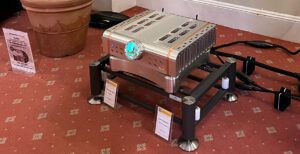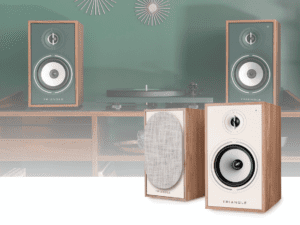
Perhaps one of the more interesting developments we have seen in the world of audio in recent years is the rise in the availability of high-resolution recordings, together with the equipment necessary to play these files. The origins of this development lie in the dissatisfaction, among some, with the quality of sound coming from Compact Disc. To be fair, much of this criticism came from the fact that, in the early days of CD, every record label rushed to reissue their analogue catalogue on the new medium with little thought of audio quality. It was deemed sufficient to have pop and click free sound. Consequently, the promise of CD was not really exploited until much further down the line. The fact is, CDs can sound absolutely wonderful with a top quality recording and attention paid to mastering and production. However, in many aspiring audiophile minds, the damage had been done and CDs became the villain.
So, we saw a move back to vinyl, which has been very good for the industry, and a parallel interest in high-resolution digital files. But are we in danger of falling into a similar trap as in the 1970s, where specifications alone were all-important? To answer this question, we need to give some serious thought to how we hear, and the reality of making high-resolution recordings.
Let’s get technical for a moment. The CD format of 16bit dynamics and 44.1kHz sampling frequency provides for a frequency range from 0Hz to around 22kHz, i.e., beyond the accepted range of human hearing, together with a dynamic range of around 95dB. More than enough to cover the extremes of almost all available musical instruments and performances. The broadcast standard of 24bit at 48kHz extends the dynamic range to just short of 150dB and the uppermost frequency to 24kHz. This will cover just about everything coming from natural sources. However, audiophiles like to revel in 24bit 96kHz sampling, which extends the upper frequency to around 48kHz, or 24bit 192kHz sampling which extends the upper limit to around 96kHz, and we can even go further than this. These rarefied upper frequency ranges are, of course, well beyond the range of human hearing and one might well ask the simple question, why? (actually, that is a very good question to ask in many instances).
Those who passionately support Hi-Res will say that, while they cannot hear anything at these frequencies, they can ‘feel’ a difference in the music. Often this is suggested as an enhanced airiness. Oh yes? With what sensory organ do they hear this airiness? Certainly not their ears. While it is true that you can ‘feel’ very low frequencies, if applied at high amplitude and at close quarters, this is a different phenomenon as it is simply the large acoustic waves hitting our bodies at a wavelength that we interact with. It is more probable that what the Hi-Res fans hear is an additional smoothness to the sound as a result of the higher frequency sampling and, of course, the ADC components used in 192kHz recordings are probably going to be of good quality which, itself, will write its signature on the final sound. As someone who has recorded orchestras and folk ensembles at a variety of sampling rates, I can, even with my ageing hearing, notice a very slight difference in the smoothness of sound at 96kHz compared to 44.1kHz when listening to the original, first generation recordings, but it is a very small difference and other factors within the recording chain can make a larger difference to the overall quality of sound.
An interesting test, let’s call it the BAT (Better Audio Technology) test, would be to get a friend to obtain a small number of high quality recordings at a variety of sample rates and place these, in random order, upon a high performance Digital Audio Player. Place a piece of electrical tape over the display of the player so that you have no idea of the resolution being played. Now, with a pad and paper, listen to all the recordings and make a note of what you hear and which examples sound better to you. If you can reliably determine the different sampling frequency rates, in the right order, then you may be blessed with extraordinary hearing.
Most of us who fall in the ‘beyond middle age’ range will be lucky if we can hear a fundamental tone at 15kHz. By the time we reach 60 years of age, this may drop to around 12–13kHz for the average male, a little higher perhaps for females. So, a signal at 96kHz is going to mean little to us. But we probably will perceive that additional smoothness in the middle frequencies that Hi-Res can (sometimes) provide. There are many other factors to consider when evaluating the quality of recordings though, some of which have a far greater impact. One may also like to consider the frequency range present in a typical, orchestral recording, such as the supplied spectrogram of ‘Finlandia’ by Sibelius.
As may be seen, there is some energy extending to 20kHz, in fact, there are some small harmonics at 22kHz, but most of the energy lies in a band extending from around 50Hz to about 9kHz, after which, it tapers of quite quickly. By 15kHz there is relatively little signal, so what would be the point of recording at 48kHz or above? There is nothing there, at least not with conventional instruments.
We then have the question of how original recordings are made, and with what equipment. Most recording engineers have favourite microphones and mixing components. It is ironic that many of these condenser microphones from companies such as Sennheiser, Beyerdynamic, AKG, Neumann, Shure, Rode, and Audio Technica have frequency responses that drop off fairly sharply after 20kHz and, there are some often used favourites where this figure is closer to 18kHz. They will respond to nothing at 48 or 96kHz, and this is, for most purposes, a good thing, as one would not want to be injecting very high frequency noise into the mixing chain.
In order to actually record in high resolution, firstly, we need specialist microphones that can respond to these very high frequencies, without introducing too much self-noise. These are not common. Then we need microphone preamplifiers and mixers which also have this extended frequency response, together with ultra low noise capabilities and, of course, a similarly extended and clean analogue to digital converter. This sort of equipment is not something that you will find in your average recording shop. Let us suppose though, for the moment, that we have the perfect microphone, with a flat response extending from 20Hz to 96kHz and a noise floor approaching 150db, connected to a special microphone cable that can also cope with this performance criteria without mangling the sound too much. We shall feed this into an ultra low noise preamplifier and mixing section with similar specifications and then, on to our analogue to digital converter which, in turn, will output a beautiful Hi-Res sound into our digital recorder, or computer. This device, whatever it is, will need to have similarly extended specifications in order to produce our Hi-Res file.
Actually, yes, we can do all of this. But what are we to record? Which natural instruments produce identifiable sound energy at these frequencies? Recording a solo violin at 24bit 96kHz, with the musician playing the highest possible fundamental note, I noticed, on analysing the first-generation file, some feint energy (harmonics) reaching up to around 28kHz. A soprano flute may similarly produce harmonics in this area, but whether I can hear them or not is another matter. Most of the meaningful signal in my solo violin recordings may easily be contained within the CD specification of 16bit 44.1kHz sampling.
I have also been surprised, when recording a full orchestra, that the electrifying dynamic range, heard at the podium position, may easily be captured in 16bits if you get your levels set properly. Note, that I do not use any limiters in the recording chain. One can generate electronic, synthesised sounds that extend beyond the range of human hearing and, possibly, a dynamic range extending beyond 100dB. But it surely all becomes academic at these levels.
In conclusion, the author is certainly not against Hi-Res, but we should get things in perspective. The slightly increased smoothness of a 24bit 96kHz recording in the middle ranges is worth having, provided, that everything else is of a suitable quality. It is interesting that, especially within the field of classical music, many audiophiles have favourite recordings that were made in the late 50s to early 60s. Music is not just about specifications. Musical performance is the defining factor and, often, the ability to capture this performance using minimalist microphone techniques and solid engineering skills, will make the difference.
While writing this, I am listening to some jazz recordings made in the early 60s. They sound wonderful and immediate, with a great sound stage and highly musical. I don’t really care that they are not Hi-Res. The balance is good and they were obviously recorded and engineered by someone who knew what they were doing. Ahhhhh…
Tags: FEATURED
By Hi-Fi+ Staff
More articles from this authorRead Next From Blog
See all
Audio Show Deluxe 2024: A photo show report
- Mar 28, 2024

Paul Messenger 1949-2024: A personal tribute
- Mar 26, 2024

Bristol Hi-Fi Show 2024: See You There!
- Feb 21, 2024

Triangle Borea Connect
- Feb 19, 2024










